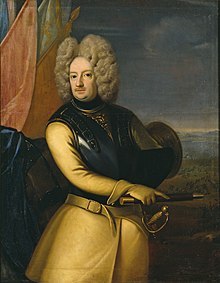Magnus Stenbock

Count Magnus Gustafsson Stenbock (* 12 May July / 22 May 1665 greg. In Stockholm ; † 12 February July / 23 February 1717 greg. In Copenhagen ) was a Swedish field marshal during the Great Northern War .
Live and act
Magnus Stenbock was the son of the last Swedish Imperial Admiral Gustaf Otto Stenbock († 1685). He studied at Uppsala University and in Paris before choosing a military career and serving in the Netherlands for some time . On his return to Sweden he became a major in the army and served the Swedes in the Netherlands and on the Rhine. In the Battle of Fleurus (1690) he was distinguished by courage and skill. In the Palatine War of Succession he was not only used militarily, but also in diplomatic missions.
Soon afterwards he led his regiment as a colonel to victory in the Battle of Narva and distinguished himself in Dünamünde , Klissow and the Battle of Cracow . In 1703 he emerged victorious from the Battle of Pultusk and three years later, meanwhile promoted to General of the Infantry , was appointed Governor General of Skåne , which he defended against the Danes in the Battle of Helsingborg . In 1711 Stenbock was given the honorary position of Chancellor at Lund University . In 1712 he became a field marshal and marched into Mecklenburg for the Pomeranian campaign with a 9,000-strong troop to defend Swedish interests on the mainland, especially in Swedish Pomerania , and to protect the particularly important bridgehead Stralsund .
In December 1712 Stenbock won the battle of Gadebusch in West Mecklenburg and moved on to the duchies of Schleswig and Holstein via Altona , which he had burned down on January 8 and 9, 1713 in retaliation for the previous Danish attack on Stade , which was then Swedish . In February 1713, in the Tönning fortress belonging to Schleswig-Holstein-Gottorf , he was surrounded by a superior force of Danish, Russian and Saxon troops with 11,000 men and surrendered on May 16 after three months of siege . He was taken into custody in Copenhagen . He ignored an offer to escape.
During the years of his imprisonment in Copenhagen, Stenbock worked as a painter, but also accomplished an astonishing work in a completely different field, namely that of craftsmanship. From the tusk of a narwhal he chiseled an extraordinarily filigree jewelry chain, the manufacture of which has not yet been fully clarified: the tiny links of the chain show no seam under the microscope. The gem, consisting of 4802 small rings, some of which measure only 3 × 0.25 millimeters, is 96 centimeters long and weighs 17.5 grams. Art historical research has identified other, somewhat less artistic gems of similar design in various collections and museums, the origin of which is now being checked.
Magnus Stenbock died in Copenhagen on February 23, 1717 and was buried in Uppsala Cathedral. In 1901 an equestrian statue was erected for him in Helsingborg .
literature
- 10. Magnus S [tenbock] . In: Theodor Westrin, Ruben Gustafsson Berg, Eugen Fahlstedt (eds.): Nordisk familjebok konversationslexikon och realencyklopedi . 2nd Edition. tape 26 : Slöke – Stockholm . Nordisk familjeboks förlag, Stockholm 1917, Sp. 1214-1218 (Swedish, runeberg.org ).
- Paul Piper: Altona's fire on January 8th, 1713. Shown on the basis of the documents. Altona 1913, pp. 9-20.
- Andreas Marklund: Stenbock, era och ensamhet i Karl XII: s tid. Historiska Media, Lund 2008, ISBN 91-85377-64-3 .
- Martin Meier: The Stenbock campaign 1712/13. A contribution to the history of operations. In: Military and Society in the Early Modern Age 16, 2012, pp. 197–217 ( opus.kobv.de PDF).
Web links
Individual evidence
- ↑ 10. Magnus S [tenbock] . In: Theodor Westrin, Ruben Gustafsson Berg, Eugen Fahlstedt (eds.): Nordisk familjebok konversationslexikon och realencyklopedi . 2nd Edition. tape 26 : Slöke – Stockholm . Nordisk familjeboks förlag, Stockholm 1917, Sp. 1214-1218 (Swedish, runeberg.org - Sp. 1215 below).
- ↑ Matthias Schulz: The Lord of the Rings. In: Der Spiegel. No. 36. Hamburg 2009, p. 114 ff. ISSN 0038-7452
| personal data | |
|---|---|
| SURNAME | Stenbock, Magnus |
| ALTERNATIVE NAMES | Stenbock, Magnus Gustafsson |
| BRIEF DESCRIPTION | Swedish field marshal |
| DATE OF BIRTH | May 22, 1665 |
| PLACE OF BIRTH | Stockholm |
| DATE OF DEATH | February 23, 1717 |
| Place of death | Copenhagen |

